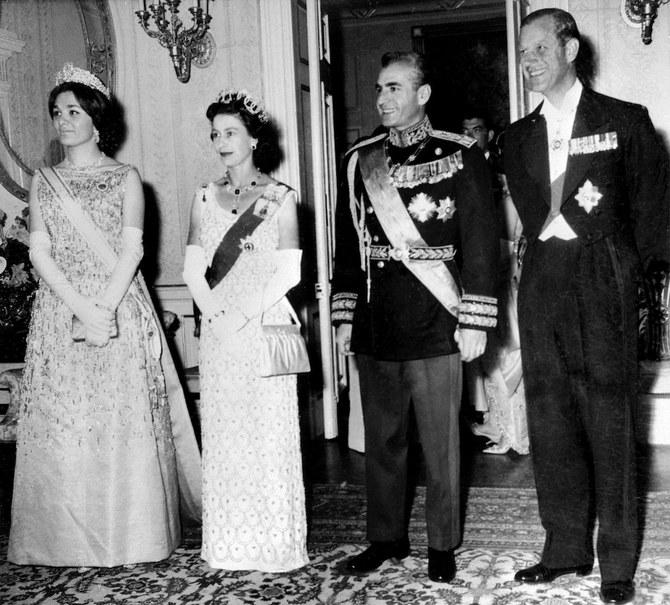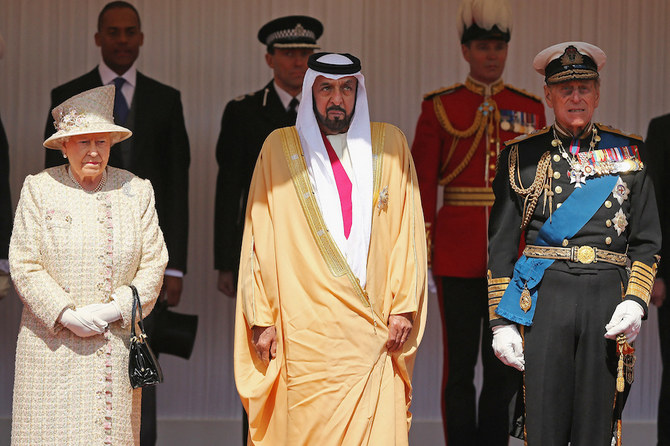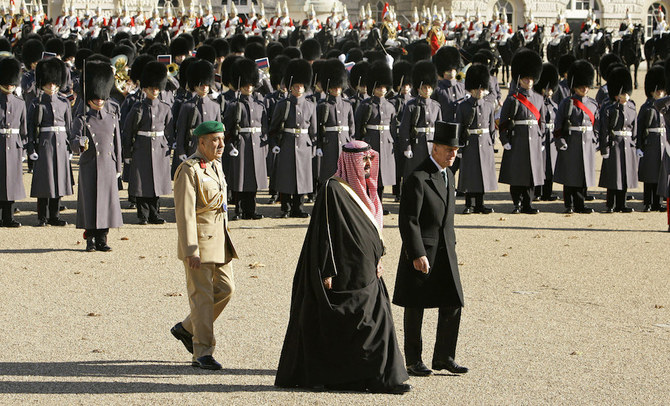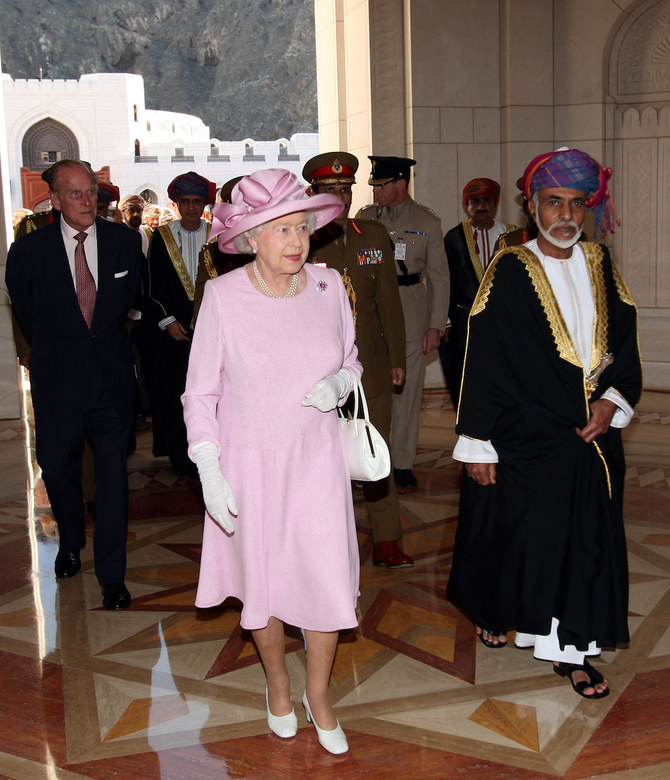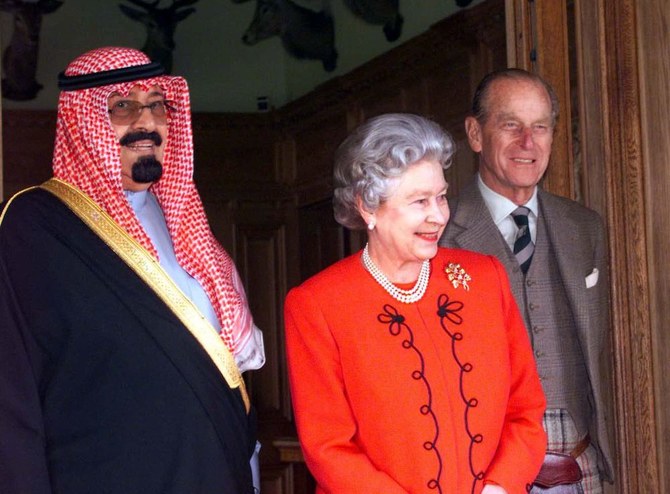LONDON: The death on Friday of Britain’s Prince Philip, the “strength and stay” of Queen Elizabeth II through the long years of her reign, is being mourned throughout the world, and nowhere more so than in the Gulf states, with which the royal couple had such an enduring and warm relationship.
The leaders of Saudi Arabia, Bahrain and Oman sent messages of condolence to the queen.
From the UAE, cables were sent by President Sheikh Khalifa bin Zayed Al-Nahyan; Sheikh Mohammed bin Rashid Al-Maktoum, UAE prime minister and ruler of Dubai; and Sheikh Mohammed bin Zayed Al-Nahyan, Crown Prince of Abu Dhabi.
In his condolence message to the queen, the British government and the people, Bahrain’s King Hamad bin Isa Al-Khalifa lauded Philip’s efforts to serve the UK and its friendly people. An Oman News Agency statement said “Sultan Haitham bin Tarik sent a cable of condolences to Her Majesty Queen Elizabeth II, Queen of the United Kingdom of Great Britain and Northern Ireland and the President of the Commonwealth.”
Born on June 10, 1921, the Duke of Edinburgh’s death — he had recently spent a month in hospital — came just two months short of his 100th birthday. His was a remarkable century.
PRINCE PHILIP: KEY DATES
* June 10, 1921 - Born on Greek island of Corfu.
* Dec 5, 1922 - Family flees to Paris when King Constantine I is overthrown.
* 1939 - Joins the Royal Navy.
* 1947 - Renounces Greek, Danish royal titles, becomes naturalized Briton.
* 1947 - Marries Princess Elizabeth at Westminster Abbey, becomes Duke of Edinburgh.
* 1952 - Wife Elizabeth becomes queen.
* 1956 - Founds Duke of Edinburgh Award, a youth self-improvement scheme.
* 1961 - Becomes first president of the World Wildlife Fund UK.
* 2017 - Steps back from royal duties, age 96.
* April 9, 2021 - Dies at Windsor Castle, age 99.
Born in Corfu as Prince Philip of Greece and Denmark, in 1939 he joined the British Royal Navy and served with distinction during the Second World War, seeing action in the North Sea, Indian Ocean and the Mediterranean, where he took part in the Battle of Crete.
He was mentioned in despatches for his service during the Battle of Cape Matapan, which also earned him the Greek War Cross, and on board the HMS Wallace he took part in the Allied invasion of Sicily.
On board the destroyer HMS Whelp with the British Pacific Fleet, he was present in Tokyo Bay to witness the formal surrender of the Japanese on Sept. 2, 1945, and the end of the Second World War.
As Prince Philip of Greece and Denmark, he had first met Princess Elizabeth, Britain’s future Queen, in 1934. At the outbreak of war, Philip, then 18, and the 13-year-old Princess began writing to each other. As he sailed the world with the Royal Navy, and she served with the Auxiliary Territorial Service (ATS), the women’s branch of the British Army, and braved the bombs of the Blitz, their letters raised each other’s spirits and they became firm friends.
INNUMBERS
* 143 - Countries visited by Prince Philip in official capacity.
* 22,191 - Solo engagements as longest-serving consort in UK history.
In July 1947, two years after the cessation of hostilities, they became engaged.
Before the engagement was announced, the prince renounced his Greek and Danish titles, adopted his maternal grandparents’ name, Mountbatten, and became a naturalized British subject.
With his dashing good looks and outstanding military record, the queen’s fiance immediately won the hearts of the British public.
On the eve of the wedding — a glittering ceremony at Westminster Abbey in London on Nov. 20, 1947, that raised the spirits not only of the British, but also a war-weary British Empire — Philip was appointed Duke of Edinburgh by the princess’s father, King George VI, and granted the title His Royal Highness.
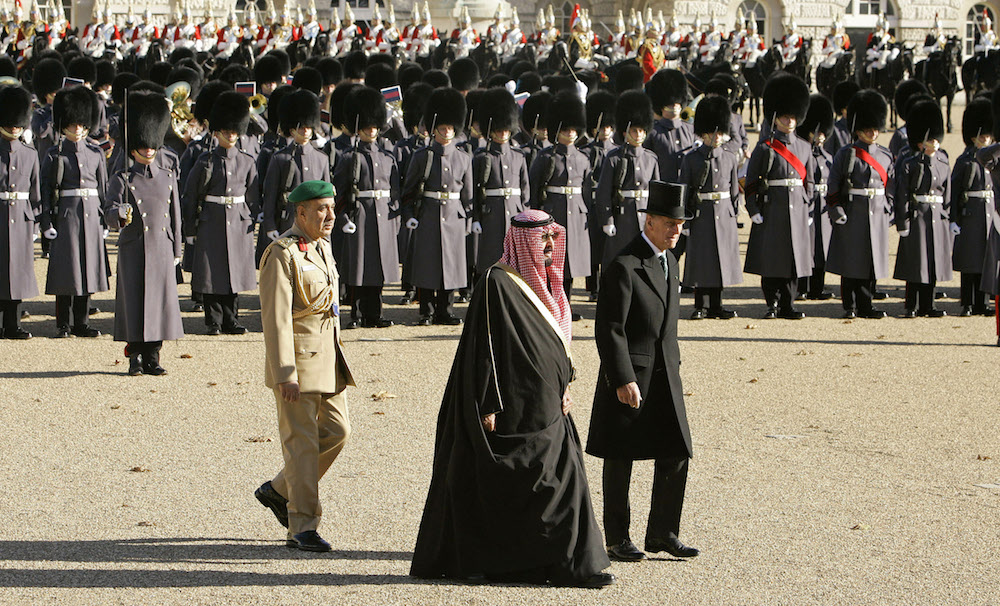
King Abdullah of Saudi Arabia, (front center) accompanied by Britain's Prince Philip, (Front R) reviews a Guard of Honor in Horse Guards, before a state carriage procession along the Mall, in London, 30 October 2007. (AFP/File Photo)
On Feb. 6, 1952, a few days after the prince and the princess had set out on their first tour of the Commonwealth, the couple received the news that Elizabeth’s father, the king, had died.
They flew straight home and from that moment on the man who had served Britain so valiantly throughout the Second World War had a new, vitally important role to play.
For the next 69 years, the great, great-grandchild of Queen Victoria would never be far from Queen Elizabeth’s side, supporting her in everything she did, from entertaining visiting heads of state to making state visits around the world.

The Queen and Duke of Edinburgh stand next to the then-Crown Prince of Saudi Arabia, Prince Abdullah Bin Abdul Aziz Al-Saud, after he arrived at Balmoral Castle for lunch during a visit to the UK. (AFP/File Photo)
A terrific conversationalist, with a quick wit, dry sense of humor and mischievous disregard for stuffy protocol, it was often Philip who put a human face on the potentially intimidating countenance of monarchy, lightening the mood and putting at ease all those daunted by the prospect of meeting the Queen.
Throughout those years both Queen Elizabeth and Prince Philip attached a special importance to maintaining Britain’s special relationship with the monarchies of the Gulf.
State visits by Queen Elizabeth II and Prince Philip to Arab countries
* Kuwait: Feb. 12-14, 1979.
* Bahrain: Feb. 14-17, 1979.
* Saudi Arabia: Feb 17-20, 1979.
* Qatar: Feb. 21-24, 1979.
* UAE: Feb. 24-27, 1979.
* Oman: Feb. 28-March 2, 1979.
* Tunisia: Oct. 21-23, 1980.
* Algeria: Oct. 25-27, 1980.
* Morocco: Oct. 27-30, 1980.
* Jordan: March 26-30, 1984.
* UAE: Nov. 24-25, 2010.
* Oman: Nov. 25-28, 2010.
In one early solo visit to the region, in February 1965 Prince Philip flew to Riyadh as the guest of Saudi Arabia’s King Faisal. Two years later, King Faisal renewed his acquaintance with the prince when he made a state visit to London.
For over 150 years Britain had had the closest ties, sealed by treaties signed in the 19th century, with what it termed the Trucial States, but on Dec. 1, 1971, those treaties were revoked.
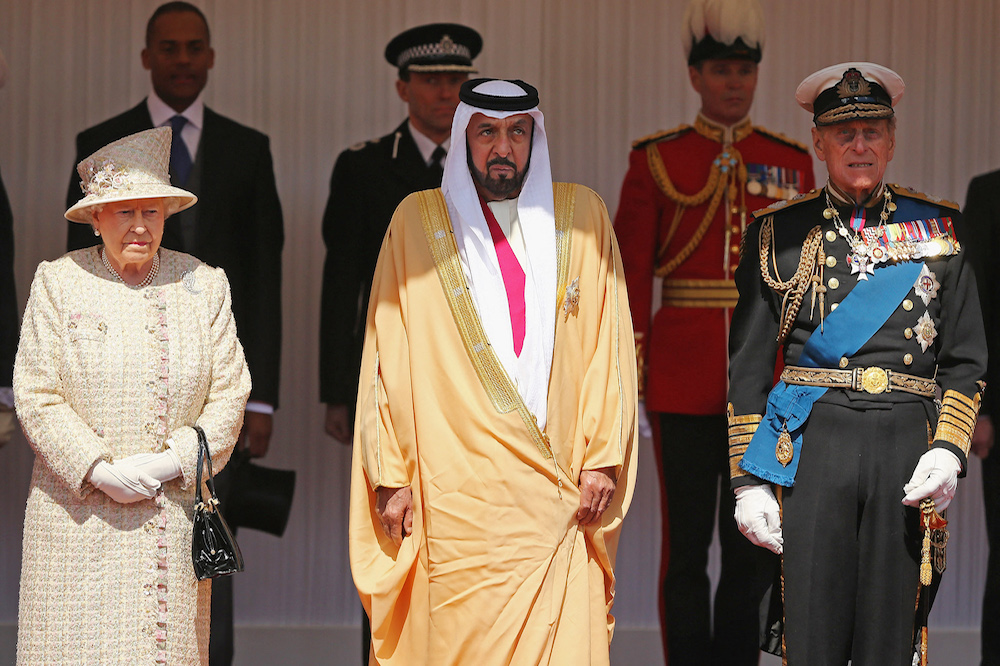
Britain's Queen Elizabeth II (L) and her husband Prince Philip (R) stand next to the President of the UAE Sheikh Khalifa bin Zayed Al-Nahayan during a Ceremonial Welcome in the town of Windsor on April 30, 2013. (AFP/File Photo)
Led by Sheikh Zayed bin Sultan Al-Nahyan, the ruler of Abu Dhabi, the Trucial States became the United Arab Emirates. However, the bonds between Britain and the Gulf states, and between the monarchy of Britain and the crowns of all the Gulf states, remained strong, thanks in no small part to the efforts of the royal couple.
Key Britain-Saudi royal visit dates
* May, 9-17, 1967: King Faisal makes UK state visit.
* Feb. 17-20, 1979: Queen Elizabeth II and Prince Philip visit Saudi Arabia.
* June, 9-12, 1981: King Khalid makes UK state visit.
* March 24-27, 1987: Saudi Arabia’s King Fahd makes UK state visit.
* Oct. 30-Nov. 1, 2007: King Abdullah makes UK state visit.
In 1979 Prince Philip was by the queen’s side when she visited the UAE, entertaining Sheikh Zayed on board the Royal Yacht Britannia, which had sailed to the Gulf for the occasion.
Thirty-one years later, there was a poignancy to the occasion when Queen Elizabeth and Prince Philip returned to Abu Dhabi in 2010, to visit Sheikh Zayed’s tomb and Grand Mosque in the company of his son, Abu Dhabi Crown Prince Sheikh Mohammed bin Zayed Al-Nahayan.
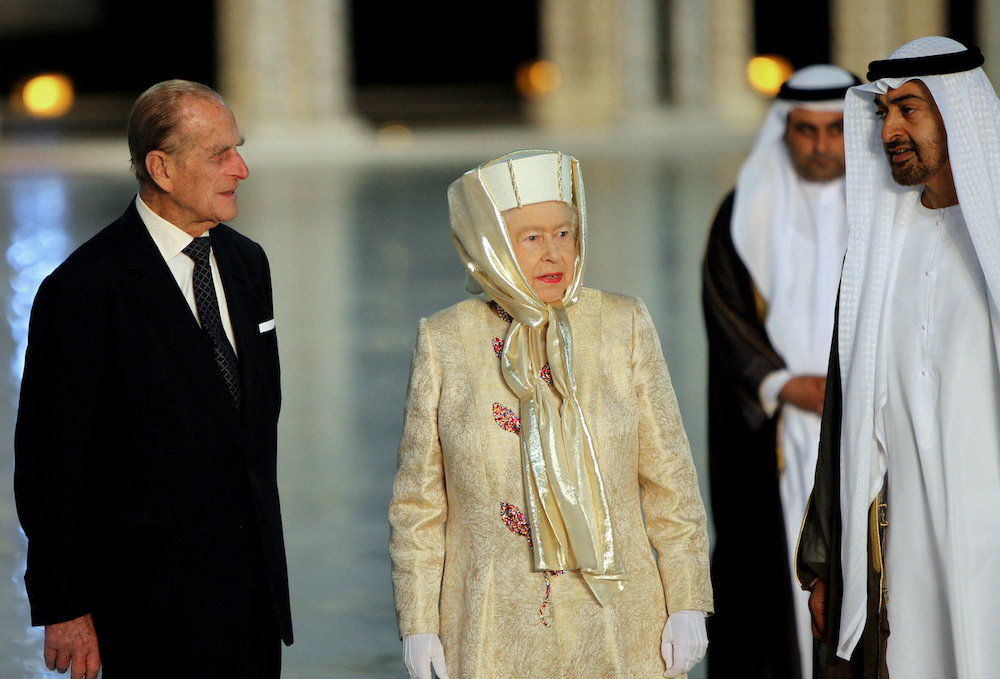
Britain's Queen Elizabeth II and her husband Prince Philip (L) stand with Abu Dhabi Crown Prince Sheikh Mohammed bin Zayed Al-Nahayan upon their arrival to visit the Sheikh Zayed Grand Mosque in the Emirati capital on November 24, 2010. (AFP/File Photo)
Some of the photographs in the album of Prince Philip’s many meetings with the states and leaders of the Middle East are overshadowed by the events that followed.
A black-and-white photograph taken on Sept. 26, 1952, for example, shows Philip, holding the hand of his daughter, Princess Ann, walking in the grounds of Balmoral Castle in Scotland with the Queen and their guests, the young King Faisal II and Prince Abdullah, the regent of Iraq. Both men, along with members of their family and staff, were brutally murdered in July 1958 when Faisal was overthrown in a bloody coup.
In March 1961, the royal couple flew to Iran for a state visit to a country that 18 years later would undergo a shocking transformation. Photographs of the visit show Prince Philip and Shah Mohammad Reza Pahlavi grinning broadly alongside the queen and Farah Pahlavi at a state occasion. In 1979 the Iranian monarchy would be swept aside by an Islamic revolution that would send shockwaves around the region.
State visits by Middle East and North African leaders to the UK
* July 16-19, 1956: Iraq’s King Faisal II.
* May 5-8, 1959: Iran’s Shah Mohammad Reza Pahlavi.
* July 19-28, 1966: Jordan’s King Hussein I and Princess Muna.
* May, 9-17, 1967: Saudi Arabia’s King Faisal.
* June, 9-12, 1981: Saudi Arabia’s King Khalid.
* March, 16-19, 1982: Oman’s Sultan Qaboos.
* April, 10-13, 1984: Bahrain’s Emir Sheikh Isa.
* Nov. 12-15, 1985: Qatar’s Emir Sheikh Khalifa.
* March 24-27, 1987: Saudi Arabia’s King Fahd.
* July 14-17, 1987: Morocco’s King Hassan II.
* July 18-21, 1989: UAE’s President Sheikh Zayed.
* July 23-26, 1991: Egypt’s President Hosni Mubarak and First Lady Suzanne Mubarak.
* May 23-26, 1995: Kuwait’s Emir Sheikh Jaber.
* Nov. 6-9, 2001: Jordan’s King Abdullah II and Queen Rania.
* Oct. 30-Nov. 1, 2007: Saudi Arabia’s King Abdullah.
* Oct. 25-28, 2010: Qatar’s Emir Sheikh Hamad.
* Nov. 27-29, 2012: Kuwait’s Emir Sheikh Sabah.
* April 30-May 1, 2013: UAE’s President Sheikh Khalifa.
But in the main, the photographic record of Prince Philip’s long relationship with the region evokes only happy memories — such as of the honeymoon visit to Britain in 1955 of King Hussein of Jordan and his wife Queen Dina, the four-day state visit to Britain in 2001 of King Abdullah and Queen Rania of Jordan, and the state visit of King Abdullah of Saudi Arabia in 2007.
The happy, laughing faces in so many of the photographs taken of Prince Philip over the years, whether on state visits or during walkabouts, also captured something of the essence of the man and the part he played in maintaining the bonds between royal families, and helping to make the monarchy accessible.
Queen Elizabeth, in a speech to mark the couple’s golden wedding anniversary in 1997, put it this way: “He has, quite simply, been my strength and stay all these years, and I, and his whole family, and this and many other countries, owe him a debt greater than he would ever claim or we shall ever know.”
----------------
Twitter: @JonathanGornall





